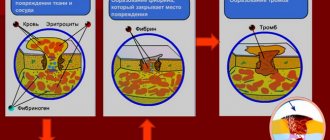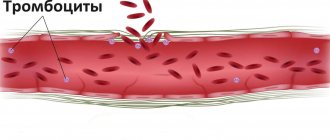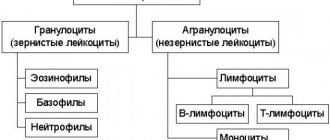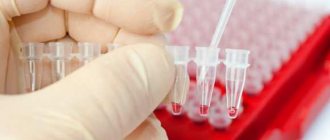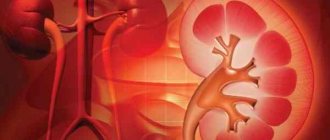Biochemical blood test in children
A biochemical blood test in children is a laboratory test that is used for diagnostic purposes. Its results help identify inflammatory and degenerative diseases so that they can be treated immediately. The procedure also allows you to assess the child’s health status.
A biochemical blood test in children helps to detect the disease in just a day and quickly begin treatment
What is blood biochemistry
A biochemical blood test is of great value in conducting laboratory tests and making the correct diagnosis of a patient, because this type of analysis is highly informative and reliable. Thanks to blood biochemistry, you can quickly learn about the condition of the patient’s internal organs, quickly identify a complex disease and effectively monitor its dynamics.
A biochemical blood test allows you to detect the slightest disturbances in the functioning of the thyroid and pancreas, pathologies of the kidneys, liver and gastrointestinal tract, as well as obtain reliable information about changes in metabolic processes.
Why is research needed?
Biochemical blood test in children is a laboratory diagnostic method that allows you to evaluate the functioning of the liver, kidneys, pancreas and other internal organs. It is informative in identifying autoimmune pathologies, endocrine and metabolic disorders. The study helps to detect the species of pathogenic microorganisms and establish their sensitivity to drugs.
During the diagnostic process, the parameters of organic compounds are determined - proteins, sialic acids, seromucoids, C-reactive protein, bilirubin and other substances from the child’s bloodstream. If their indicators are exceeded or underestimated, then further instrumental research is required.
Norms of indicators
A biochemical blood test contains more than 100 indicators that change in any, even very mild forms of disease. A specific pathology is characterized by a deviation from the permissible values of one or several indicators at the same time. In modern technologies, deciphering indicators is possible online via the Internet, but this method only allows us to assume the presence of any disease in the child. For each age category, specific indicator standards correspond. Their meaning can be seen in the table.
Main indicators of biochemical blood analysis in children
| Index | Age norm | Units | ||
| up to 1 month | up to 1 year | 1-14 years | ||
| Total protein | 49-69 | 57-73 | 62-82 | G/l |
| Albumen | 34-44 | 36-49 | 37-55 | G/l |
| Seromucoid | 0,13-0,20 | Units | ||
| Timolovaya Ave. | 0-4 | Units | ||
| C-reactive protein | Negative | |||
| Amylase | Up to 120 | U/l | ||
| ALT | Up to 40 | U/l | ||
| ACT | Up to 40 | U/l | ||
| Cholinesterase | 3000-9300 | U/l | ||
| Alkaline phosphatase | Up to 150 | Up to 644 | U/l | |
| LDH | Before 1536 | Up to 960 | Up to 576 | U/l |
| Creatine kinase | F 25-170 | |||
| M 25-200 | ||||
| ASL-0 | 50-250 | Units | ||
| Total bilirubin | 17-68 | 3,4-20,7 | µmol/l | |
| Direct bilirubin | 4,3-12,8 | 0,83-3,4 | µmol/l | |
| Bilirubin indirect | 12,8-55,2 | 2,56-17,3 | µmol/l | |
| Cholesterol | 1,6-3,0 | 1,8-4,9 | 3,7-6,5 | mmol/l |
| B-lipoproteins | 1,5-3,5 | 1,4-4,5 | 3,55-5,5 | G/l |
| Triglycerides | 0,2-0,86 | 0,39-0,93 | 0,4-1,86 | mmol/l |
| Glucose | 1,7-4,7 | 3,3-6,1 | mmol/l | |
| Urea | 2,5-4,5 | 3,3-5,8 | 4,3-7,3 | mmol/l |
| Uric acid | 0,14-0,29 | 0,14-0,21 | 0,17-0,41 | mmol/l |
| Creatinine | 35-110 | mmol/l | ||
| Potassium | 4,5-6,5 | 4,0-5,6 | 3,6-5,1 | mmol/l |
| Sodium | 135-155 | 133-142 | 132-156 | mmol/l |
| Total calcium | 2,2-2,5 | 2,3-2,87 | mmol/l | |
| Calcium ioniz. | 0,93-1,17 | 1,03-1,27 | mmol/l | |
| Phosphorus | 1,8-2,7 | 1,3-2,3 | 1,0-1,8 | mmol/l |
| Magnesium | 0,66-0,95 | 0,7-1,2 | mmol/l | |
| Copper | 1,9-10,5 | 4,2-24,0 | 11,0-25,0 | µmol/l |
| Iron | 9,8-33,0 | 6,3-15,0 | 9,3-32,0 | µmol/l |
| Chlorides | 96-107 | mmol/l | ||
| Medium molecules | E254 | 240-260 | Units | |
| E280 | ||||
| Gamma - GT | Up to 250 | Up to 177 | F 7-32 | U/l |
| M 11-50 | ||||
| Lipase | Up to 183 | U/l | ||
Deviation from acceptable values indicates the presence of inflammatory processes, chronic diseases, or may be caused by the fact that preparation for the analysis was not carried out. Let's consider several important indicators determined during the biochemistry of a child's blood.
- Glucose is a sugar present in the blood that is needed to provide energy to the body. Deviation from normal values indicates hypoglycemia (low sugar levels) or hyperglycemia (high sugar levels).
- Calcium – has an important role in the transmission of nerve impulses, the production of hormones, and muscle function. A deviation in calcium levels indicates a hormonal disorder or the presence of diseases of the liver, bone tissue, or pancreas.
- Sodium, calcium, carbonates and chlorides are necessary to balance fluid in the body. In addition, they maintain an acid-base environment. These indicators play an important role in the functioning of the heart, brain and muscles. Deviation from the norm indicates the development of heart disease, kidney pathologies or dehydration.
- Urea and creatinine are end products of the metabolic process and are excreted from the body through the kidneys. An increase in their indicator when deciphered means that disturbances in the functioning of the kidneys occur.
As already noted, a large number of indicators are considered in a biochemical study. Each of them is important for the child’s body. When a disease is suspected, only certain indicators are usually considered.
In what cases is examination necessary?
Carrying out a biochemical blood test in children is practiced at any age. It is required immediately after the birth of a child to exclude the presence of congenital or genetically determined diseases. Laboratory testing is indicated for complaints of fatigue, weakness, pain of any localization. Its indicators help to make a verdict about the child’s readiness to attend the sports section.
What becomes the basis for ordering such a detailed examination:
- doctor’s suspicions of a pathology occurring in the body, including congenital;
- jaundice of newborns;
- assumption of infection of the child during intrauterine development;
- the need to confirm a preliminary diagnosis;
- increased body temperature over a long period of time in the range of 37.1-38.0°C;
- abdominal pain that can only be temporarily eliminated with medication;
- severe digestive and peristalsis disorders.
The norm of one or another laboratory test value indicates the child’s good health. Therefore, in pediatrics it is often used to monitor the effectiveness of treatment.
A biochemical blood test in children is carried out in a laboratory within 1-3 days
Preparatory stage
To obtain reliable laboratory test results the first time, preliminary preparation is required. Before the diagnostic procedure, you should not eat for eight hours. To examine a child, you need to choose the morning hours, when he is not yet hungry after sleep; he can easily refuse breakfast.
What other measures should parents take to obtain accurate indicators:
- exclude foods high in fat, salt, and spices from your diet per day;
- talk to the child as an adult, explain the need for the procedure so that during it he does not get nervous or worried;
- do not give drugs from the groups of antibiotics, cytostatics, glucocorticosteroids, antimycotics. If their appointment is vital, notify the doctor who will perform the decoding.
The test results may be affected by excessive physical activity of the child. Therefore, the day before, you need to give up outdoor games and keep him busy reading books or drawing.
How is the procedure performed?
When drawing blood, the laboratory technician asks the child to straighten his arm at the elbow joint, and after applying a tourniquet, clench and unclench his fist. To prevent infection of the puncture, the skin is pre-treated with an alcohol-containing antiseptic. When collecting material, only sterile syringes can be used. At the final stage of the procedure, the laboratory assistant applies a cotton swab soaked in alcohol to the skin puncture site.
Further research and interpretation of results rarely last more than a day. The laboratories are equipped with all the necessary equipment for sedimenting blood cells, separating fractions, and performing qualitative and quantitative chemical reactions. After receiving the data form, you need to visit the attending physician, who will issue a final conclusion. If he doubts the results, a retake will be required. In this case, preparation must be carried out especially carefully.
Before performing a biochemical analysis, blood is taken from a vein in children.
Interpretation of results
Some parents are so worried about their child’s health that they try to decipher the results and make a diagnosis on their own. There is no point in this. The doctor has sufficient experience to determine why the norm was exceeded or the value was too low. It analyzes the parameters of several biologically active substances that are interconnected.
Which organic compounds are most important for assessing health status:
- Blocks: 57-73 g/l (1 month - 1 year), 62-82 g/l (1 year - 14 years). Exceeding these values indicates a decrease in fluid content in the body. This condition is typical for respiratory and intestinal infections, digestive and peristalsis disorders due to poisoning or intoxication, disorders of the kidneys and liver;
- C-reactive protein: 0.5 g/l (1 month - 1 year), 0.5 g/l (1 year - 14 years). If the norm of this parameter is exceeded, then an acute, subacute or chronic inflammatory process occurs in the child’s body.
- Albumin: 35-48 g/l (1 month - 1 year), 36-55 g/l (1 year - 14 years). The usual concern is a decrease in these proteins in the systemic circulation. It may indicate anemia due to blood loss, deficiency of B vitamins, disorders of the kidneys, ureters, bladder, and metabolic disorders.
- Seromucoids: 0.13-0.2 g/l (1 month - 1 year), 0.13-0.2 g/l (1 year - 14 years). Decreased levels are a signal of liver damage due to inflammatory pathology. Excessively high values indicate ongoing destructive processes.
- Total bilirubin: 3.4 -12.7 g/l (1 month - 1 year), 3.4-12.7 g/l (1 year - 14 years). An increased level of this bile pigment is often detected when there is a malfunction of the liver and gallbladder, or the development of hepatitis.
- Alanine aminotransferase: 10-40 g/l (1 month - 1 year), 10-40 g/l (1 year - 14 years). Exceeding the norm is often observed in patients with cardiovascular and renal chronic pathologies.
- Lipids 1.8-4.9 g/l (1 month - 1 year), 3.7 6.5 g/l (1 year - 14 years). High values of biochemical blood test in children indicate poor condition of large and small vessels. Further instrumental testing of the heart and kidneys is required.
Targeted research is also practiced to detect a specific organic substance. For example, the quantitative content of sialic acids helps to detect damage to the musculoskeletal system.
A biochemical blood test is the most important diagnostic procedure. Accurate determination of the level of lipids, proteins, micro- and macroelements allows timely detection of pathology and initiation of therapy.
source
Features of preparation for research
The results of the study may be incorrect if you do not prepare for it correctly. A distorted result may not only not provide the necessary benefit for assessing a person’s health status, but also significantly harm him.
If the analysis shows elevated values other than normal, the doctor can prescribe appropriate therapy for the person.
- Blood is donated exclusively on an empty stomach. Therefore, the test is usually taken in the morning after at least 10 hours of fasting.
- The only liquid you are allowed to drink before the test is plain water.
- Chewing gum is also prohibited.
- You need to stop playing sports, eating fried, fatty and spicy foods 3 days before biochemistry.
- You should not take any medications for a week. If it is not possible to stop taking it, you should notify your doctor. He will consider the results taking this factor into account.
- Thermal effects (bath) before the procedure are prohibited.
- If the child gets nervous before the appointment, then you need to wait a little, take a breath and calm down.
- You should not brush your teeth before the test, otherwise deviations in glucose levels may be detected.
- When donating blood again, the procedure must be carried out at the same time and in the same place.
In emergency cases, blood is taken for analysis without preparation. But in this case, after 1-2 days a repeat analysis is carried out, which helps to adjust the prescribed treatment. The results of the study can be found out within a day.
Who is prescribed the analysis?
Blood biochemistry plays a decisive role in the diagnosis of many diseases, so the analysis is prescribed for any complaints and pathological conditions. A doctor can issue a referral for testing if a child has a stomach ache, prolonged diarrhea, vomiting, jaundice and many other conditions. The main indications for biochemistry are:
- presence of hereditary diseases;
- diseases of internal organs;
- diabetes mellitus or suspicion of it;
- disruption of the cardiovascular system;
- intoxication;
- avitaminosis.
In addition, the first biochemical analysis is carried out in the maternity hospital in order to identify hereditary enzymopathies.
How to take blood and do the analysis
Blood is drawn from the ulnar vein using a disposable syringe. A tourniquet is applied above the injection site. The injection site is treated with an antiseptic and 5 ml of blood is collected. After drawing blood, a cotton swab or alcohol pad is applied to the injection site, which must be held pressed against the skin for 5 to 10 minutes to prevent bleeding.
In infants, blood is taken from the heel using a thin needle.
Blood testing is carried out using special equipment - an analyzer. The analysis result can be obtained within 24 hours.
Decoding the analysis result
Depending on the degree of deviation of the test results from the norm, one can judge whether the child has a disease. The table shows the most significant indicators for diagnosis and possible reasons for their changes.
| Index | Level up | Level reduction |
| Protein |
|
|
| Albumen |
|
|
| ALaT and ASaT |
| |
| Cholesterol |
|
|
| Glucose |
|
|
| Bilirubin |
| |
| GGT |
| |
| C-reactive protein |
| |
| Urea |
| |
| Creatinine |
| |
| Lipase |
| |
| Amylase |
|
|
| Uric acid |
| |
| Alkaline phosphatase |
| |
| Creatine kinase |
|
- Biochemistry results taken from different laboratories may vary significantly. In this regard, when deciphering the analysis, it is necessary to build on the standards indicated on the form of a particular laboratory.
- A week before the test, it is advisable to avoid taking medications that affect metabolic processes. If this is not possible, be sure to tell your doctor what medications you are giving your child.
Only an experienced specialist can decipher blood biochemistry. It is impossible to judge the child’s condition from just one analysis. For a correct diagnosis, other studies are necessary, such as a clinical blood test, computed tomography, ultrasound and others.
source
Purpose of the study
The very first blood donation for biochemical analysis is carried out in the maternity hospital to identify hereditary enzymopathies. After all, a newborn must be checked for cystic fibrosis, phenylketonuria, galactosemia, adrenogenital syndrome or congenital hypothyroidism, for example. At such an early stage, no other analysis will show the presence of possible abnormalities in the newborn, except for a biochemical blood test. The purpose of this blood test is to determine various diseases and abnormalities in the child’s body by determining the ratios of blood components. For diagnosis, not all the blood is needed, but only its plasma (the transparent and liquid part).
In addition, a biochemical blood test is also prescribed for older patients. Biochemistry reveals the following parameters in the sample:
- total protein and nitrogenous components. A small amount of protein (hypoproteinemia) is observed in diseases of the kidneys or thyroid gland, burns, intoxication, regular malnutrition, nosebleeds, stomach and bladder cancer, hepatitis and cirrhosis, reduced absorption of substances. An increase in the amount of total protein (hyperproteinemia) can occur due to cholera, repeated vomiting, inflammation, kidney or liver dysfunction, dehydration, burns, multiple myeloma, joint pathologies and malignant granulomas;
- urea. Its amount increases with pyelonephritis, endocrine disorders, burns, poisoning with certain types of salts, due to prolonged compartment syndrome, arterial hypertension, renal tuberculosis, polycystic kidney disease and acute renal failure. The decrease occurs as a result of glucose administration, liver failure, fasting, decreased metabolism, liver tissue damage;
- bilirubin (pigments). Its level increases with liver tumors, cirrhosis, hepatitis, poisoning, fatty degeneration and infections. A decline is observed with cardiac ischemia or long-term use of ascorbic acid;
- enzymes (alpha-amylase, alaniaminotransferase (ALT), aspartate aminotransferase (AST), pancreatic amylase, diastase). ALT and AST increase with viral hepatitis, liver damage, cancer and metastases in the liver and liver crash syndrome;
- fats, cholesterol, lipoproteins (lipids) . The most important factor in the analysis is total cholesterol. It increases with diabetes mellitus, pregnancy, cholelithiasis, pancreatitis, pancreatic or prostate cancer, hypertension, myocardial infarction, hyperlipidemia, and coronary heart disease. Decreased due to liver cancer, cirrhosis, rheumatoid arthritis, hyperthyroidism, prolonged fasting, chronic lung diseases and malabsorption of substances;
- glucose and lipase . Hypoglycemia (glucose deficiency) occurs during fasting, liver, gastrointestinal and kidney diseases, insulin overdose, meningitis, carbohydrate malabsorption, sarcoidosis and insulinoma. Hyperglycemia (excess glucose) manifests itself in diabetes mellitus, tumors in the pituitary gland, adrenal tumors, epilepsy, injuries and brain tumors, carbon monoxide poisoning, burns, pathology of the endocrine glands, psychoemotional agitation and during treatment with glucocorticoids;
- antibodies to Epstein-Barr virus;
- magnesium, potassium, chlorine, sodium and calcium (electrolytes). Potassium and sodium are the most important electrolytes in the blood. Their deficiency or excess can lead to consequences such as arrhythmia, difficulty breathing, convulsions, vomiting, general weakness and even coma;
- creatinine It increases with tumors of muscle tissue or the urinary system, excessive stress, intestinal obstruction, pneumonia, jaundice or liver atrophy. The decrease occurs due to fasting or when taking corticosteroids.
Interpretation of biochemical blood test indicators in children
When a child gets sick or simply feels unwell, his parents, alarmed, seek medical help. To obtain a diagnosis, the doctor prescribes certain examinations, among which a biochemical blood test occupies an important place.
This is a deeper and more extensive study than a general or clinical analysis; it will help an experienced specialist identify the true cause of the ailment, make a diagnosis and quickly move on to treating the disease. A timely blood sample can speed up the recovery of a small patient and minimize possible risks, in particular, the occurrence of complications.
Appointment for analysis
A biochemical blood test is an effective diagnostic tool to assess the functioning and condition of internal organs
In most cases, a biochemical blood test in children is prescribed to confirm a preliminary diagnosis or refute it. Such a test can show how healthy the child is or what abnormalities are present in his body. The list of parameters for such an analysis includes more than a hundred indicators, so the doctor can mark on the procedure form only those that he needs to obtain.
Based on the results of the analysis and other studies, examination of the child and conversation with his parents, the doctor can draw conclusions about the state of his health and the presence or absence of any pathology. All parameters are assessed comprehensively, since in a small child they can quickly and easily change depending on many different reasons - excitement, body temperature and surrounding age, food eaten and many other factors.
Often it is a blood test in infants and toddlers that allows us to find the source of a disease that could not be determined otherwise.
Such a test may be required to diagnose inflammatory processes in the body, assess water-salt metabolism and electrolyte balance, determine the correct functioning of the kidneys and liver, as well as the systems associated with these organs.
Preparation and procedure
One of the important factors that influence the reliability of the result is proper preparation for the analysis.
In principle, according to medical requirements, a biochemical blood test in children is performed according to the same requirements as in adults. However, the younger the child, the more questions his parents have about preparing for the test.
- The blood test should be carried out on an empty stomach, the minimum period of fasting is about 12 hours before the blood is drawn.
- It is best to take the test in the morning.
- Your child can be given clean water, but not juice or sugary drinks.
- Parents should try to distract the baby to avoid excessive excitement and whims - this may negatively affect the results of the study.
- If the child is old enough, you need to make sure that on the eve of donating blood he eats the same foods and dishes as usual. Do not introduce new foods or drinks into his menu, avoid exotic fruits and juices, as well as an abundance of sweets, pastries and chocolate.
- If possible, you should avoid taking any medications that could affect the child’s metabolism at least 7 days before the test. If this is not possible, you need to provide the doctor with the relevant information. It will be taken into account in the process of drawing conclusions from the analysis.
There seems to be nothing confusing about this list, but parents of small children, especially infants, know very well what a hungry child in line to donate blood is capable of. If an infant is to donate blood, he must not be fed, so this point in preparation for the test can be skipped. Fasting such a small child will distort the blood sample data much more than taking breast milk or a special milk formula. This food is quickly absorbed, so the child can and should be fed, but not just before the blood draw.
More information about biochemical blood tests can be found in the video:
It is difficult to persuade a small child who does not yet understand the importance of the procedure to be patient for several hours. He can make a terrible scandal while waiting for his turn for analysis in the laboratory, which will have an extremely negative impact on the result of the sample. The baby needs to be fed before leaving the house with food that will take a long time to digest and create a feeling of fullness. It is important to avoid sweet foods, sugar in any form and drinks - this can greatly distort the glucose test, and this is a very important indicator.
You can consult your pediatrician about feeding a young child.
He will give precise recommendations on what dishes can be given to the baby, and what type of food should be completely excluded from his menu.
Another important aspect of preparation is psychological balance. The child instinctively copies the behavior of his parents. If they are nervous, this will definitely be passed on to the baby. Take care to take his favorite toy, read him a book in line, distract him from thoughts about the future procedure.
Take care to minimize disruption to the child during blood collection. To do this, dress it so that you can easily and simply roll up your sleeve to take a sample. Blood is taken from a vein, most often in the elbow. If the baby cries, distract his attention with some toy or treat - after drawing blood, you can eat. In newborns, blood is taken from the heel, in older children - from a vein in the bend of the elbow. The hand above the vessel is pulled with a tourniquet. If the child is nervous and timid, you can play at home to imitate this process, then it will not be so painful and frighteningly unusual for the baby.
How is blood taken from a vein from a baby?
First of all, a blood test from a vein is performed on an empty stomach. Therefore, it is worth signing up for it early in the morning so that the child can eat afterwards. It is very difficult to follow this rule with newborns and infants. But if you need an accurate result, for example when measuring glucose levels, then you should seriously discuss this issue with your pediatrician and find the optimal solution.
How is blood taken from a vein from a baby, namely, where (from which veins):
- Elbow bend.
The most common place to take blood from a vein in babies. The procedure is carried out in the same way as for adults: the arm is tied with a tourniquet, the injection site is lubricated with alcohol, a vein is punctured, then blood is collected in a test tube, the tourniquet is removed, the needle is removed and a cotton swab with alcohol is applied.
This blood collection site is not suitable for newborns and infants under 3-4 months of age, since the child is too small and it is not possible to feel the veins.
- Veins of the forearm.
- Back of the hand.
- Veins on the head/forehead, calves of the legs.
These blood collection sites are used when a vein for blood collection cannot be accurately located elsewhere in the baby's body.
Tips before taking a blood test from a vein
To make the process less worrying, it is advisable to take the test in a trusted clinic with a qualified, experienced nurse.
If you are asked to leave during a blood draw, treat this with understanding. There is no need for unnecessary nervousness, and nothing bad will happen in a couple of minutes of your absence. If the medical staff practices drawing blood without the presence of parents, then this is a proven and productive method, rest assured that everything will go well.
To distract/entertain your child, bring your favorite rattle. Or let it be new to interest the baby and help him quickly forget the unpleasant process.
After the procedure, give your child good positive emotions - hug and kiss, do what he loves with him - build a pyramid, read a book, watch your favorite cartoon, so that there is no negativity left.
Taking blood from a vein is an alarming process for both mother and baby. Painful sensations will cause slight discomfort to the baby, but within a few minutes they will disappear without a trace. Don’t create panic, be confident in the necessity of what is happening, then your child, looking at you, will behave calmer. Be healthy!
On this topic:
- How to collect a urine test from a baby (boy and girl)?
When a child gets sick, parents call a doctor at home or go to the clinic. After an examination, pediatricians prescribe tests that help understand the cause of the disease. Including a blood test for the baby.
Decoding the main indicators
Only the attending physician can correctly decipher the LBC in children, since the norm of indicators depends on the age of the child
In most cases, when a biochemical blood test is performed in children, they are limited to the so-called basic metabolic set. It includes eight basic indicators that provide the necessary information about the child’s health status. Using them, the doctor judges the functioning of all systems and organs: tests for kidney function, fluid levels and electrolyte balance (very important for diagnosing dehydration, which often occurs with vomiting and diarrhea in babies), glucose and calcium levels in the blood.
Blood counts vary between children of different ages, and many laboratories may use slightly different evaluation criteria, so test results may vary from place to place.
Only a pediatrician can correctly evaluate all the data, since you need to focus on a whole range of tests and studies.
Having received a form with the results of the analysis, parents should not be afraid of numbers that will differ from their own indicators. This is as it should be - the younger the child, the more striking this difference can be. So you should entrust this work to a professional who necessarily takes into account the age of the child and, based on the data obtained, as well as other research results, forms an opinion about the presence or absence of health problems in the child.
As already mentioned, a biochemical analysis may include more than 100 different indicators, but the most important, informative and frequently studied are the following:
- Protein. The amount of this substance in the blood shows the level of metabolic processes occurring in the child’s body. Protein is a kind of transport vehicle for moving lipids, hormones and other very important substances throughout the body. Elevated levels of protein in a child’s body may indicate a developing inflammatory process, existing kidney disease, or dehydration, which causes thickening and an increase in the amount of protein in the blood. The latter condition is a common occurrence in young children with dyspeptic disorders, vomiting and diarrhea.
- In addition to total protein, important information is provided by indicators such as albumin, globulin, and c-reactive protein. These protein fractions may indicate the presence of inflammation, disruption of the enzyme and immune systems, and hormonal imbalances.
- Bilirubin levels help assess the condition of the liver and are important in determining the cause of jaundice.
- Enzymes show liver function, and alkaline phosphatase helps diagnose acute leukemia.
- Glucose is a source of energy for cell life and reproduction. It makes it possible to assess metabolism, diagnose diabetes mellitus or malnutrition, and the baby’s exhaustion.
- Creatinine and urea indicate the condition and function of the kidneys.
- Lipids, triglycerides and cholesterol are indicators of fat metabolism in a child’s body.
- Basic microelements (potassium, calcium, sodium and phosphorus) are substances that are extremely important for the full formation, development and functioning of the child’s entire body.
Each of the elements that make up the blood has its own function and carries useful information about the overall health of the body, therefore all information obtained from samples and examination results must be analyzed and evaluated comprehensively.
Protein indicator
The protein content in the blood indicates the intensity of metabolic processes in the child’s body. This substance is a kind of transport that moves hormones, oxygen, lipids and other important compounds to all points of the body.
If the protein in the blood is higher than normal, this may indicate inflammation, kidney pathologies, or dehydration of the body, which causes compaction and increased protein concentration. In case of abnormalities, the child’s urine should also be examined.
Dehydration often occurs in babies who have had diarrhea and vomiting. In addition to total protein, the following parameters are distinguished:
- Globulin,
- Albumen,
- C-reactive protein (CRP).
The study of these compounds in the blood helps to determine pathologies of the immune system, inflammatory processes, malfunctions of the kidneys, liver, and endocrine glands.
